A Multiobjective, Lion Mating Optimization Inspired Routing Protocol for Wireless Body Area Sensor Network Based Healthcare Applications
Abstract
1. Introduction
2. Existing Studies in BASNs
3. Challenges and Research Motivations
- A novel, multiobjective lion mating optimization algorithm is proposed to avoid local search problems during tackling the various objectives in the given problem search space.
- A multiobjective, lion mating optimization based routing mechanism is proposed to provide robust, reliable, and energy-efficient delivery of patient data to the medical data center in dynamic situations, where doctors or autodiagnostic systems can react to abnormal situations.
- Extensive simulation studies are performed using MATLAB 9.5 (R2018b) to validate the performance of the proposed scheme against the existing routing protocols designed for BASN-based health monitoring applications.
4. Proposed SARP Routing Protocol for BASNs
4.1. Network Model and Assumptions
4.2. Bio-Inspired Computing and Optimization Problems
4.2.1. Multiobjective Problems (MOPs)
4.2.2. Multiobjective Lion Mating Optimization Algorithm (MLOA)
4.3. Mapping LMO for BASNs
| Algorithm 1: pseudo code for LMO in SARP. |
| Input: Generate a random population of Lions, i.e., sensor nodes in a search space Output: Cluster-based routing solution for BASNs. Procedure: Initialize all sensor nodes with the parameters given in Table 3
|
4.4. Working Principle of Sensors in SARP
4.4.1. Updating Neighbors with Recent Information
4.4.2. Dynamic Cluster Formation
4.4.3. Packet Forwarding Over a Set of Optimal Biosensors
4.4.4. Route Repair Procedure
5. Path Loss and Energy Consumption Models
6. Performance Analysis
7. Conclusions
Supplementary Materials
Supplementary File 1Author Contributions
Funding
Acknowledgments
Conflicts of Interest
References
- Roy, M.; Chowdhury, C.; Aslam, N. Designing Transmission Strategies for Enhancing Communications in Medical IoT Using Markov Decision Process. Sensors 2018, 18, 4450. [Google Scholar] [CrossRef] [PubMed]
- Ullah, F.; Ullah, Z.; Ahmad, S.; Islam, I.U.; Rehman, S.U.; Iqbal, J. Traffic priority based delay-aware and energy efficient path allocation routing protocol for wireless body area network. J. Ambient Intell. Humaniz. Comput. 2019, 10, 1–20. [Google Scholar] [CrossRef]
- Bhattacharya, T.; Biswas, S.; Aslam, N.; Chattopadhyay, S. Posture detection using WBAN and its application in remote healthcare monitoring. In Proceedings of the 2016 International Conference on Wireless Communications, Signal Processing and Networking (WiSPNET), Chennai, India, 23–25 March 2016; pp. 2027–2034. [Google Scholar]
- Whiting, D.R.; Guariguata, L.; Weil, C.; Shaw, J. IDF diabetes atlas: Global estimates of the prevalence of diabetes for 2011 and 2030. Diabetes Res. Clin. Pract. 2011, 94, 311–321. [Google Scholar] [CrossRef] [PubMed]
- Khan, Z.A.; Sivakumar, S.; Phillips, W.; Aslam, N. A new patient monitoring framework and Energy-aware Peering Routing Protocol (EPR) for Body Area Network communication. J. Ambient Intell. Humaniz. Comput. 2014, 5, 409–423. [Google Scholar] [CrossRef]
- Niu, S.; Matsuhisa, N.; Beker, L.; Li, J.; Wang, S.; Wang, J.; Jiang, Y.; Yan, X.; Yun, Y.; Burnett, W.; et al. A wireless body area sensor network based on stretchable passive tags. Nat. Electron. 2019, 2, 361–368. [Google Scholar] [CrossRef]
- Salayma, M.; Al-Dubai, A.; Romdhani, I.; Nasser, Y. Wireless body area network (WBAN): A survey on reliability, fault tolerance, and technologies coexistence. ACM Comput. Surv. (CSUR) 2017, 50, 3. [Google Scholar] [CrossRef]
- Khan, Z.; Aslam, N.; Sivakumar, S.; Phillips, W. Energy-aware Peering Routing Protocol for indoor hospital Body Area Network Communication. Procedia Comput. Sci. 2012, 10, 188–196. [Google Scholar] [CrossRef]
- Sonavane, S.; Tamhankar, S.; Rathi, M.; Kazi, F. A comprehensive dialogue for U-body sensor network (UBSN) with experimental case study. In Sensors for Health Monitoring; Elsevier: Amsterdam, The Netherlands, 2019; pp. 47–68. [Google Scholar]
- Faheem, M.; Shah, S.B.H.; Butt, R.A.; Raza, B.; Anwar, M.; Ashraf, M.W.; Ngadi, M.A.; Gungor, V.C. Smart grid communication and information technologies in the perspective of Industry 4.0: Opportunities and challenges. Comput. Sci. Rev. 2018, 30, 1–30. [Google Scholar] [CrossRef]
- Faheem, M.; Gungor, V.C. Energy efficient and QoS-aware routing protocol for wireless sensor network-based smart grid applications in the context of industry 4.0. Appl. Soft Comput. 2018, 68, 910–922. [Google Scholar] [CrossRef]
- Khan, R.A.; Mohammadani, K.H.; Soomro, A.A.; Hussain, J.; Khan, S.; Arain, T.H.; Zafar, H. An energy efficient routing protocol for wireless body area sensor networks. Wirel. Pers. Commun. 2018, 99, 1443–1454. [Google Scholar] [CrossRef]
- Khan, R.A.; Pathan, A.-S.K. The state-of-the-art wireless body area sensor networks: A survey. Int. J. Distrib. Sens. Netw. 2018, 14. [Google Scholar] [CrossRef]
- Yessad, N.; Omar, M.; Tari, A.; Bouabdallah, A. QoS-based routing in Wireless Body Area Networks: A survey and taxonomy. Computing 2018, 100, 245–275. [Google Scholar] [CrossRef]
- Kumar, P.; Kumari, S.; Sharma, V.; Sangaiah, A.K.; Wei, J.; Li, X. A certificateless aggregate signature scheme for healthcare wireless sensor network. Sustain. Comput. Inform. Syst. 2018, 18, 80–89. [Google Scholar] [CrossRef]
- Ahmed, S.; Javaid, N.; Yousaf, S.; Ahmad, A.; Sandhu, M.M.; Imran, M.; Khan, Z.A.; Alrajeh, N. Co-LAEEBA: Cooperative link aware and energy efficient protocol for wireless body area networks. Comput. Hum. Behav. 2015, 51, 1205–1215. [Google Scholar] [CrossRef]
- Khan, Z.A.; Sivakumar, S.; Phillips, W.; Robertson, B.; Javaid, N. QPrd: QoS-aware peering routing protocol for delay-sensitive data in hospital body area network. Mob. Inf. Syst. 2015, 2015, 153232. [Google Scholar] [CrossRef]
- Ha, I. Even energy consumption and backside routing: An improved routing protocol for effective data transmission in wireless body area networks. Int. J. Distrib. Sens. Netw. 2016, 12, 1–20. [Google Scholar] [CrossRef]
- Arbia, D.B.; Alam, M.M.; Attia, R.; Hamida, E.B. ORACE-Net: A novel multi-hop body-to-body routing protocol for public safety networks. Peer Peer Netw. Appl. 2017, 10, 726–749. [Google Scholar] [CrossRef]
- Bhangwar, A.R.; Kumar, P.; Ahmed, A.; Channa, M.I. Trust and thermal aware routing protocol (TTRP) for wireless body area networks. Wirel. Pers. Commun. 2017, 97, 349–364. [Google Scholar] [CrossRef]
- Anwar, M.; Abdullah, A.H.; Altameem, A.; Qureshi, K.N.; Masud, F.; Faheem, M.; Cao, Y.; Kharel, R. Green Communication for Wireless Body Area Networks: Energy Aware Link Efficient Routing Approach. Sensors 2018, 18, 3237. [Google Scholar] [CrossRef]
- Jamil, F.; Iqbal, M.; Amin, R.; Kim, D. Adaptive Thermal-Aware Routing Protocol for Wireless Body Area Network. Electronics 2019, 8, 47. [Google Scholar] [CrossRef]
- Abidi, B.; Jilbab, A.; Mohamed, E.H. An energy efficiency routing protocol for wireless body area networks. J. Med. Eng. Technol. 2018, 42, 290–297. [Google Scholar] [CrossRef] [PubMed]
- Ullah, Z.; Ahmed, I.; Razzaq, K.; Naseer, M.K.; Ahmed, N. DSCB: Dual sink approach using clustering in body area network. Peer Peer Netw. Appl. 2019, 12, 357–370. [Google Scholar] [CrossRef]
- Kaur, N.; Singh, S. Optimized cost effective and energy efficient routing protocol for wireless body area networks. Ad Hoc Netw. 2017, 61, 65–84. [Google Scholar] [CrossRef]
- Yan, J.; Peng, Y.; Shen, D.; Yan, X.; Deng, Q. An Artificial Bee Colony-Based Green Routing Mechanism in WBANs for Sensor-Based E-Healthcare Systems. Sensors 2018, 18, 3268. [Google Scholar] [CrossRef]
- Rabby, M.K.M.; Alam, M.S.; Shawkat, M.S.A. A priority based energy harvesting scheme for charging embedded sensor nodes in wireless body area networks. PLoS ONE 2019, 14, e0214716. [Google Scholar] [CrossRef]
- Abidi, B.; Jilbab, A.; Mohamed, E.H. Wireless body area network for health monitoring. J. Med. Eng. Technol. 2019, 4, 2183–2186. [Google Scholar] [CrossRef]
- Meharouech, A.; Elias, J.; Mehaoua, A. Moving Towards Body-to-Body Sensor Networks for Ubiquitous Applications: A Survey. J. Sens. Actuator Netw. 2019, 8, 27. [Google Scholar] [CrossRef]
- Banerjee, S.; Chowdhury, C.; Chattopadhyay, S.; Aslam, N. Two Phased Routing Protocol Incorporating Distributed Genetic Algorithm and Gradient Based Heuristic in Clustered WSN. Wirel. Pers. Commun. 2017, 97, 5401–5425. [Google Scholar] [CrossRef]
- Wang, G.-G.; Deb, S.; Cui, Z. Monarch butterfly optimization. Neural Comput. Appl. 2019, 31, 1995–2014. [Google Scholar] [CrossRef]
- Heidari, A.A.; Pahlavani, P. An efficient modified grey wolf optimizer with Lévy flight for optimization tasks. Appl. Soft Comput. 2017, 60, 115–134. [Google Scholar] [CrossRef]
- Yazdani, M.; Jolai, F. Lion optimization algorithm (LOA): A nature-inspired metaheuristic algorithm. J. Comput. Des. Eng. 2016, 3, 24–36. [Google Scholar] [CrossRef]
- Zhang, Q.; Yang, S.; Jiang, S.; Wang, R.; Li, X. Novel prediction strategies for dynamic multi-objective optimization. IEEE Trans. Evol. Comput. 2019. [Google Scholar] [CrossRef]
- Faheem, M.; Ngadi, M.A.; Gungor, V.C. Energy Efficient Multi-Objective Evolutionary Routing Scheme for Reliable Data Gathering in Internet of Underwater Acoustic Sensor Networks. Ad Hoc Netw. 2019, 93, 101912. [Google Scholar] [CrossRef]
- Packer, C.; Scheel, D.; Pusey, A.E. Why lions form groups: food is not enough. Am. Nat. 1990, 136, 1–19. [Google Scholar] [CrossRef]
- Scheel, D.; Packer, C. Group hunting behaviour of lions: A search for cooperation. Anim. Behav. 1991, 41, 697–709. [Google Scholar] [CrossRef]
- Wang, R.; Zhang, Q.; Zhang, T. Decomposition-based algorithms using Pareto adaptive scalarizing methods. IEEE Trans. Evol. Comput. 2016, 20, 821–837. [Google Scholar] [CrossRef]
- Wang, H.; Wu, Z.; Rahnamayan, S.; Liu, Y.; Ventresca, M. Enhancing particle swarm optimization using generalized opposition-based learning. Inf. Sci. 2011, 181, 4699–4714. [Google Scholar] [CrossRef]
- Viittala, H.; Hamalainen, M.; Iinatti, J.; Taparugssanagorn, A. Different experimental WBAN channel models and IEEE802. 15.6 models: Comparison and effects. In Proceedings of the 2009 2nd International Symposium on Applied Sciences in Biomedical and Communication Technologies, Bratislava, Slovakia, 24–27 November 2009; pp. 1–5. [Google Scholar]
- Van Roy, S.; Quitin, F.; Liu, L.; Oestges, C.; Horlin, F.; Dricot, J.; de Doncker, P. Dynamic channel modeling for multi-sensor body area networks. IEEE Trans. Antennas Propag. 2012, 61, 2200–2208. [Google Scholar] [CrossRef]
- Faheem, M.; Abbas, M.Z.; Tuna, G.; Gungor, V.C. EDHRP: Energy efficient event driven hybrid routing protocol for densely deployed wireless sensor networks. J. Netw. Comput. Appl. 2015, 58, 309–326. [Google Scholar] [CrossRef]
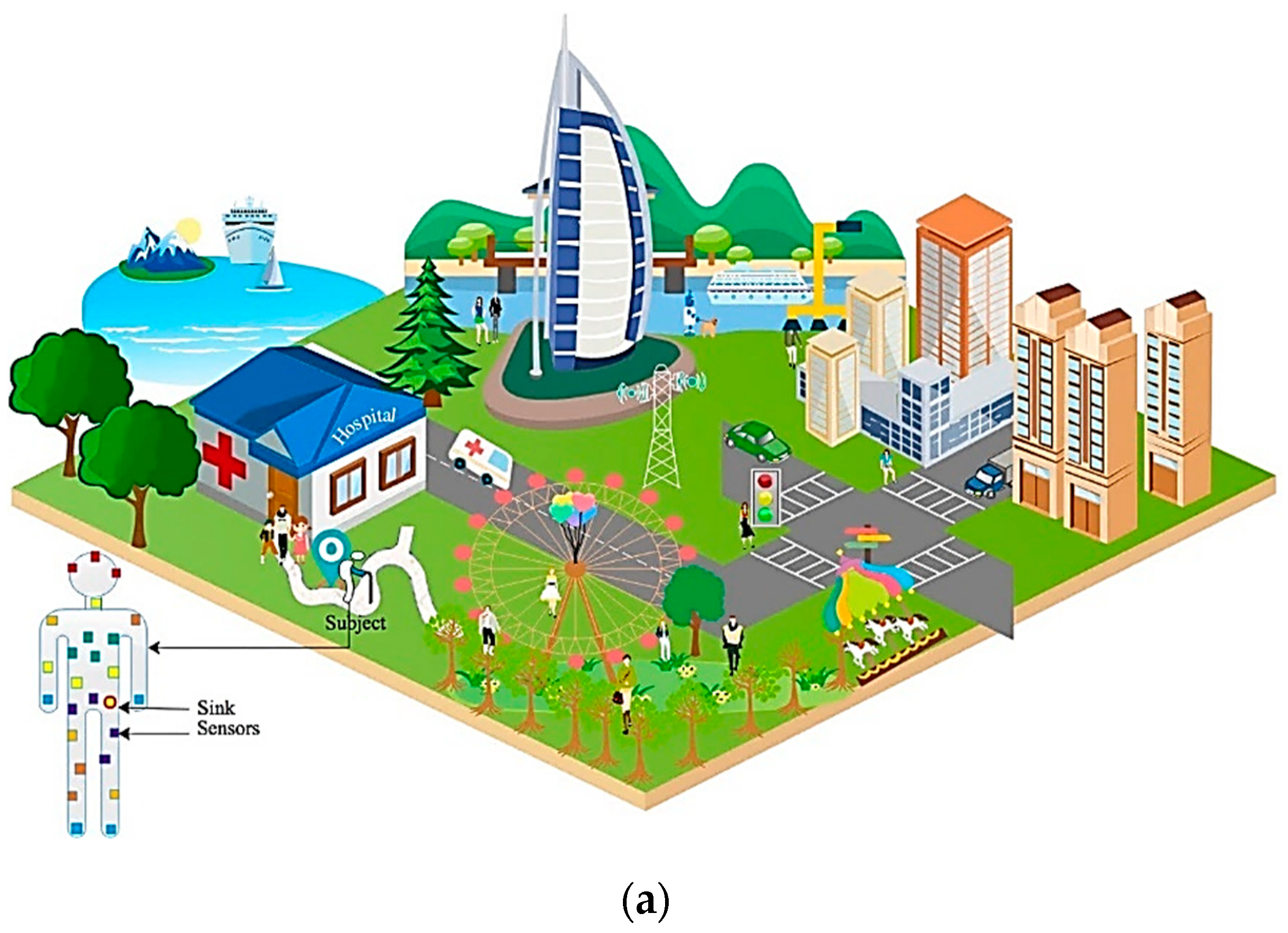
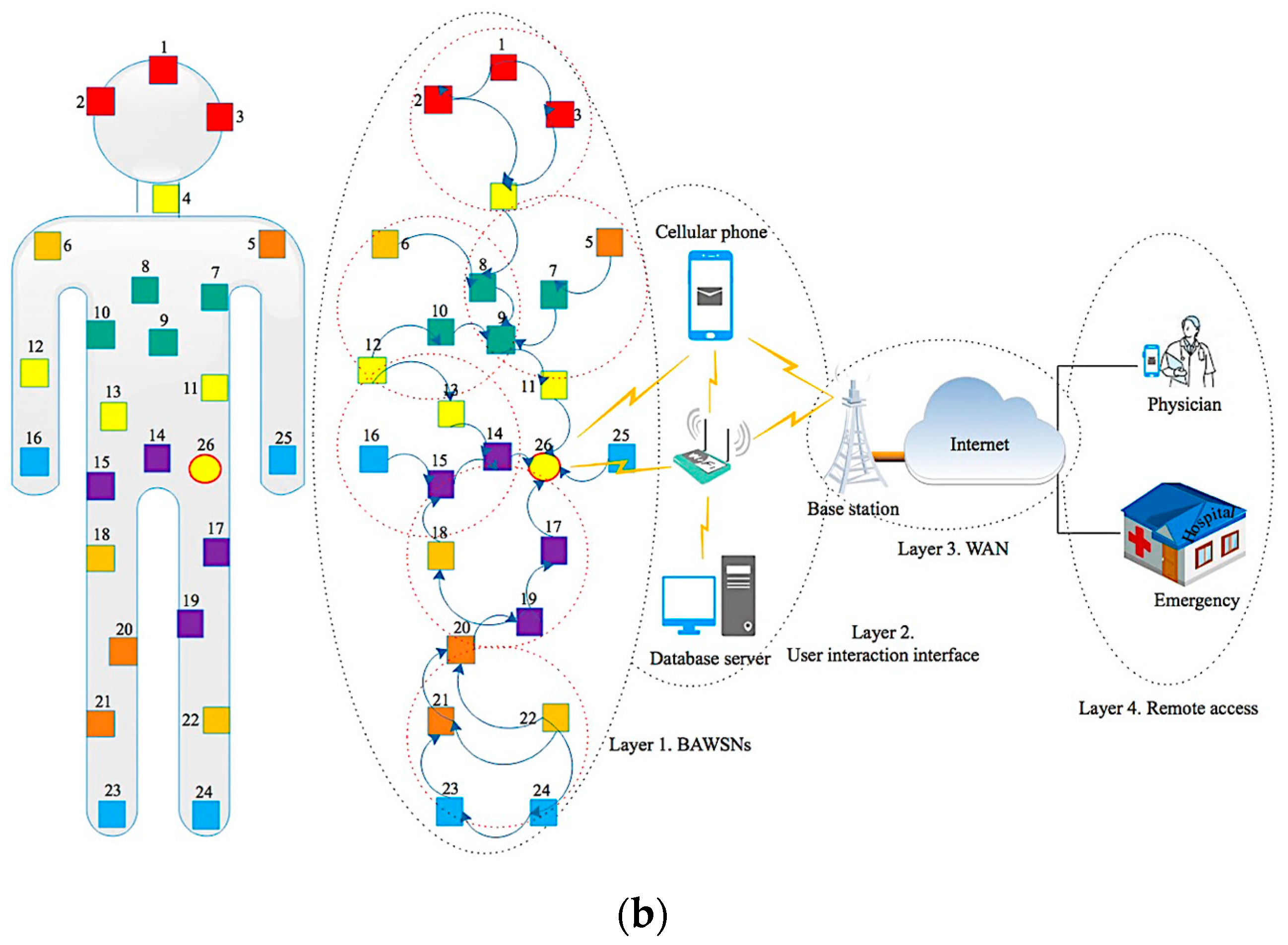


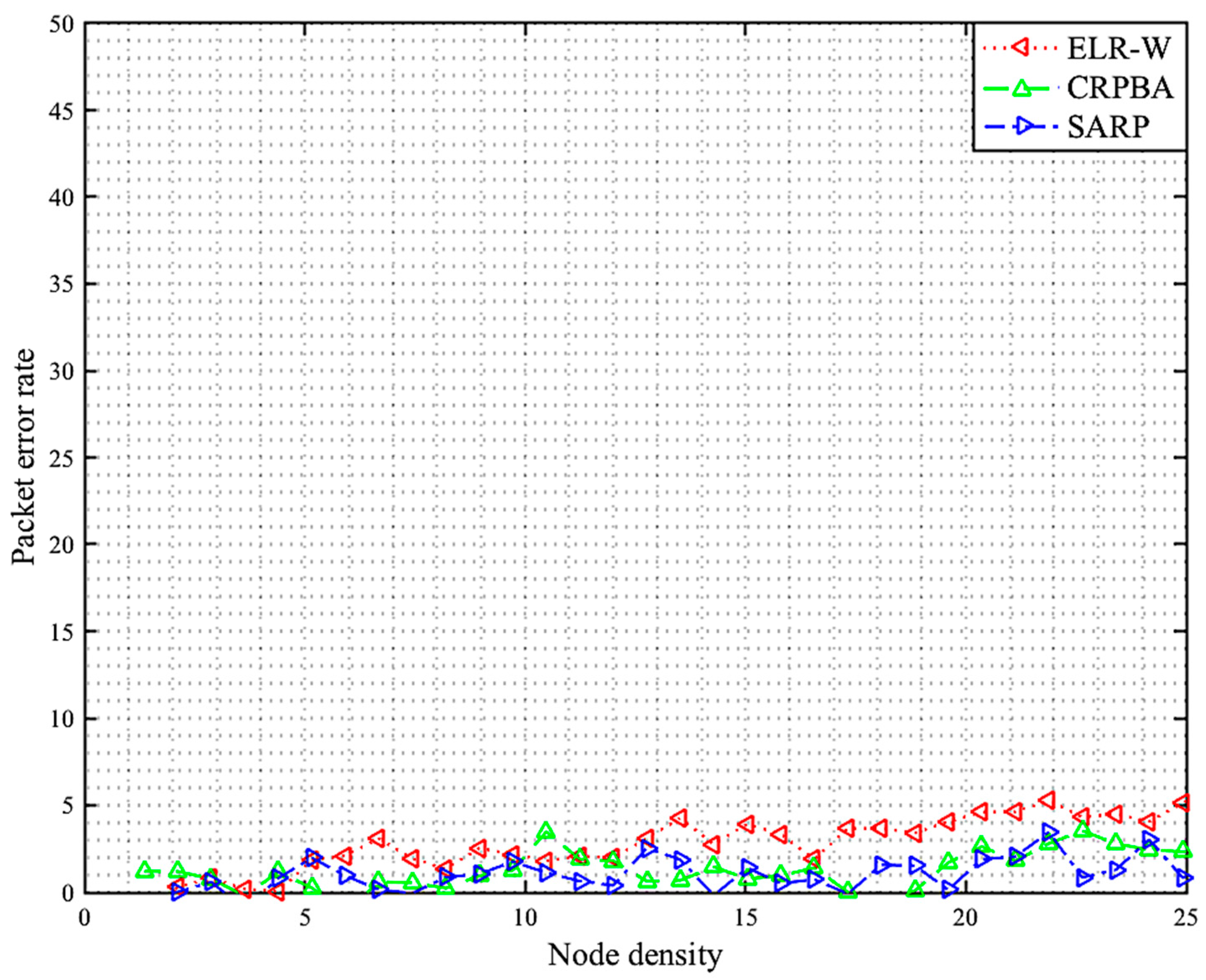
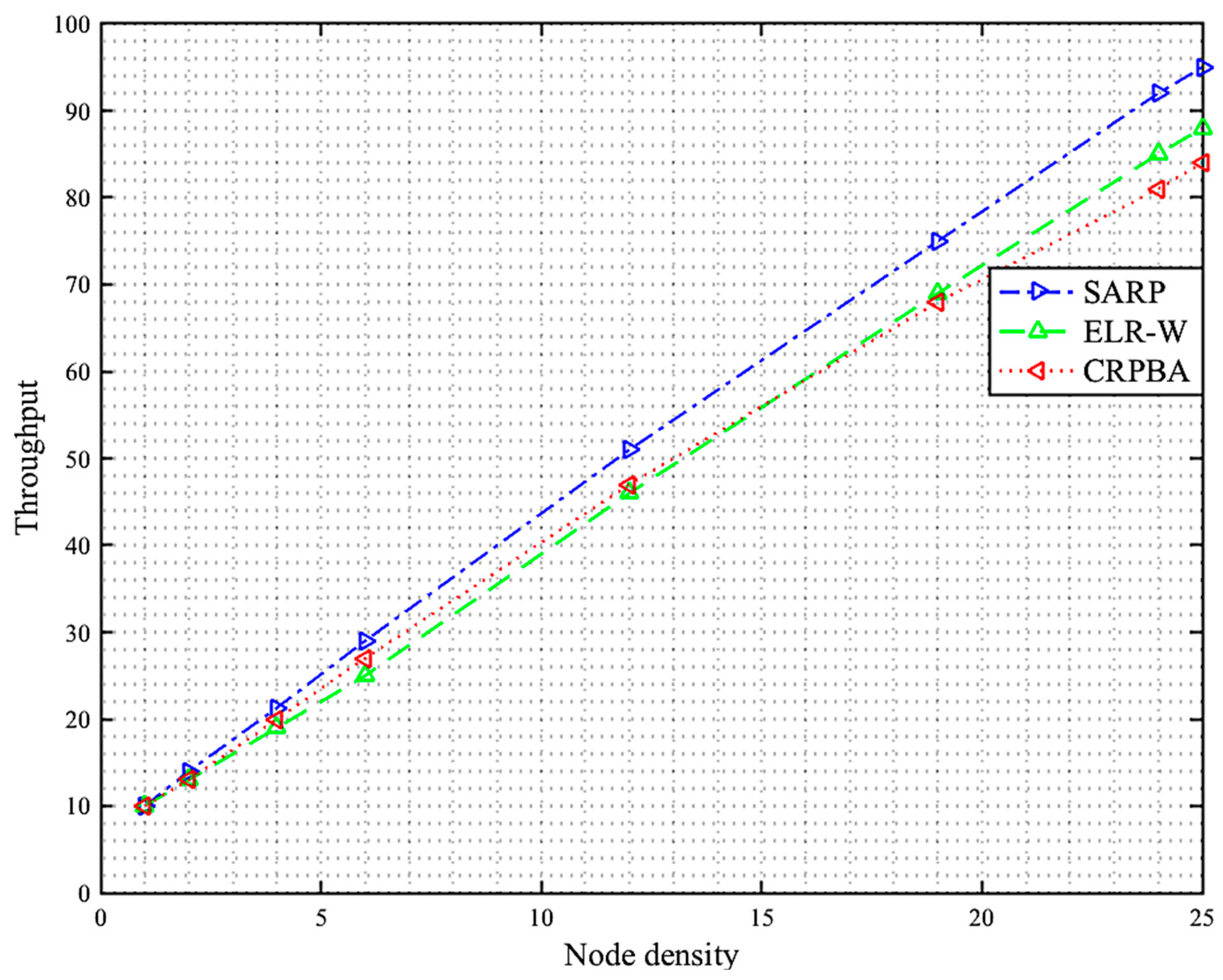
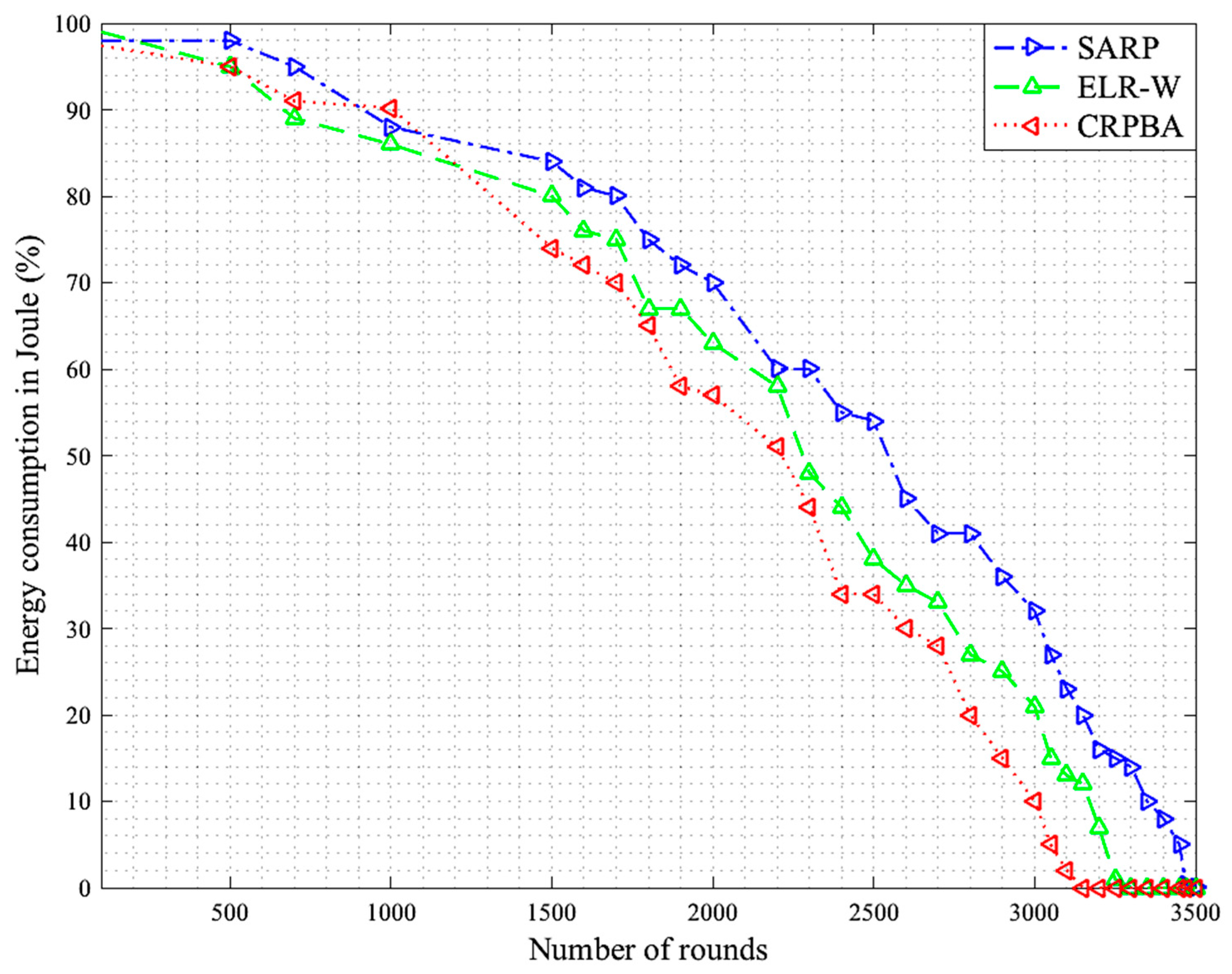
| Sr. No. | Routing Protocols | Static- Channel | Architecture | Packet Delivery Ratio | Delay | Energy Consumption | Packet Error Rate | Throughput | Reliability | Robustness | Convergence |
|---|---|---|---|---|---|---|---|---|---|---|---|
| 1 | Co-LAEEBA [16] | ✓ | Flat | ✓ | ✓ | ✓ | |||||
| 2 | QPRD [17] | ✓ | Flat | ✓ | ✓ | ✓ | |||||
| 3 | M-ATTEMPT [18] | ✓ | Flat | ✓ | ✓ | ✓ | |||||
| 4 | E-OCER [25] | ✓ | Flat | ✓ | ✓ | ||||||
| 5 | ORACE-Net [19] | ✓ | Flat | ✓ | ✓ | ✓ | |||||
| 6 | TTRP [20] | ✓ | Flat | ✓ | ✓ | ✓ | ✓ | ||||
| 7 | OEABC [26] | ✓ | Flat | ✓ | ✓ | ||||||
| 8 | CRPBA [23] | ✓ | Clustering | ✓ | |||||||
| 9 | REPC [12] | ✓ | Flat | ✓ | ✓ | ||||||
| 10 | ELR-W [21] | ✓ | Flat | ✓ | ✓ | ||||||
| 11 | DSCB [24] | ✓ | Clustering | ✓ | ✓ | ✓ | |||||
| 12 | Tripe-EEC [2] | ✓ | Flat | ✓ | ✓ | ✓ | |||||
| 13 | ATAR [22] | ✓ | Flat | ✓ | ✓ | ✓ | |||||
| 14 | SARP (Proposed) | ✓ | Clustering | ✓ | ✓ | ✓ | ✓ | ✓ | ✓ | ✓ | ✓ |
| Notation | Explanation |
|---|---|
| is the energy consumption subject to minimization by lion . | |
| is the delay needing to be minimized by lion . | |
| is the packet delivery ratio needing to be increased by lion . | |
| is the throughput subject to being increased by lion . | |
| , | indicates the lower and upper bounds of the search space, respectively. |
| represents the matrix for saving the position of each hunter by considering the position. | |
| is the value of the th dimension of the th hunter. | |
| is the number of hunters, and is the number of variables. | |
| is the current location of the prey. | |
| is the new position of the prey. | |
| is the current position of the hunter. | |
| is the percentage of improvement in the fitness of the hunter. | |
| is the network position of the hunter. | |
| is a random number whose value is either 0 or 1. | |
| is the distance between two lions or between lions and prey in the search space. | |
| is the distance between the female lion’s location and the certain point chosen by tournament selection among the pride’s territory. | |
| is a vector whose start point is the previous location of the and its direction is toward the selected position , and is perpendicular to , i.e., and . | |
| are random vectors with values in [0, 1]. | |
| linearly decreases from 2 to 0 over the course of iterations. | |
| is a vector that generates random values greater than 1 or less than −1. | |
| is a vector that generates random values in [0, 2]. | |
| is the number of lions in a pride , which improves their fitness in the last iteration. | |
| shows the position of the selected th hunter at the th iteration. | |
| is the position of the prey or a hunter in the search space. | |
| is the distance between the male lion’s position and the selected area of territory. | |
| is the angle to search for a wider area around the current solution in the search space. | |
| is a random, uniformly distributed number between and . | |
| β | is a randomly generated number with a normal distribution with mean value 0.5 and standard deviation between 0 and 1. |
| Xσ | is a shadowing factor in dB, which is a Gaussian-distributed random variable with mean zero and standard deviation σ. |
| (r) | is the energy required by the transmit amplifier to maintain an acceptable signal-to-noise ratio to transfer data messages reliably. |
| is the path loss exponent, considered as 2 in free space, and varies for different body locations. |
| Parameters | Value (s) |
|---|---|
| Channel | Body channel |
| Network topology | Deterministic |
| Biosensor deployment area | |
| Sink location area | |
| Initial node energy | 0.5 J |
| Initial sink energy | 10 kJ |
| Number of biosensor nodes | 25 |
| Number of sink nodes | 1 |
| Number of female lions | 10 |
| Number of male lions | 14 |
| Cost of high transmission | 30 nJ/bit |
| Cost of low transmission | 23 nJ/bit |
| Cost of reception | 7 nJ/bit |
| Idle power | 0.90 nJ |
| Data aggregation power | 5 nJ/bit/signal |
| Signal amplifying power | 10 pJ/bit/ |
| High communication range of sensors | 0.5 m |
| Low communication range of sensors | 0.3 m |
| Transmission range of sink | 1 m |
| Line-of-sight (LOS) | 3.38 |
| Non-line-of-sight (NLOS) | 5.90 |
| Bandwidth | 20 MHz |
| Maximum data rate | 151.8 kbps |
| Packet size | 3 kb |
| Control packet size | 50 bits |
| Packet generation rate | 0.01 packets/s |
| Memory size | 0.3 MB |
| Modulation scheme | DPSK |
| Physical layer | IEEE 802.15.6 |
| Antenna | Omnidirectional |
| Simulation time per epoch | 80 s |
| Number of runs | 53 |
© 2019 by the authors. Licensee MDPI, Basel, Switzerland. This article is an open access article distributed under the terms and conditions of the Creative Commons Attribution (CC BY) license (http://creativecommons.org/licenses/by/4.0/).
Share and Cite
Faheem, M.; Butt, R.A.; Raza, B.; Alquhayz, H.; Abbas, M.Z.; Ngadi, M.A.; Gungor, V.C. A Multiobjective, Lion Mating Optimization Inspired Routing Protocol for Wireless Body Area Sensor Network Based Healthcare Applications. Sensors 2019, 19, 5072. https://doi.org/10.3390/s19235072
Faheem M, Butt RA, Raza B, Alquhayz H, Abbas MZ, Ngadi MA, Gungor VC. A Multiobjective, Lion Mating Optimization Inspired Routing Protocol for Wireless Body Area Sensor Network Based Healthcare Applications. Sensors. 2019; 19(23):5072. https://doi.org/10.3390/s19235072
Chicago/Turabian StyleFaheem, Muhammad, Rizwan Aslam Butt, Basit Raza, Hani Alquhayz, Muhammad Zahid Abbas, Md Asri Ngadi, and Vehbi Cagri Gungor. 2019. "A Multiobjective, Lion Mating Optimization Inspired Routing Protocol for Wireless Body Area Sensor Network Based Healthcare Applications" Sensors 19, no. 23: 5072. https://doi.org/10.3390/s19235072
APA StyleFaheem, M., Butt, R. A., Raza, B., Alquhayz, H., Abbas, M. Z., Ngadi, M. A., & Gungor, V. C. (2019). A Multiobjective, Lion Mating Optimization Inspired Routing Protocol for Wireless Body Area Sensor Network Based Healthcare Applications. Sensors, 19(23), 5072. https://doi.org/10.3390/s19235072






